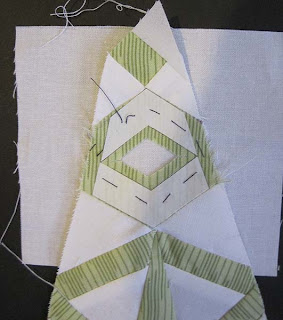The second to last block!
What am I going to do with my time when this quilt is finished?
Print or trace the block diagram onto foundation paper, number, and cut out the sections as below.
Foundation piece each section and trim the seam allowances to 1/4".
Print or trace the block diagram onto the dull side of freezer paper and cut out the sections as below. Keep the small semi-circles you cut out from the bottom of the sections.
Because I use freezer paper to foundation piece, I just reused those sections. You don't have to number them.
Iron the freezer paper sections to the right side of the matching pieced sections, lining up the seam lines. Cut along the curved edge, leaving a small seam allowance for turning under. Clip the seam allowance along the curve.
Cut two squares about 3" x 3" out of main block fabric and lay them right side up on the table.
Place the pieced sections right side up on top of them and baste along the bottom curve about 1/4" inside the freezer paper edge.
Reverse applique along the curved edge.
Iron the little freezer paper semi-circles into place and trim the block sections to size along the bottom edge(1/4" outside the freezer paper edges). Cut away the excess fabric from the back of the block sections.
Cut the non-pieced block sections out of appropriate fabric, remembering to add 1/4" seam allowance.
Sew the three bottom block sections together.
Attach the next section. Yes, inset seams are required.
Attach the small pieced section. When the angle is this sharp, I sew one seam by machine and applique the other edge. Sounds weird, I know, but it helps me avoid stretching the fabric by trying to manipulate it under the sewing machine foot.
Print/trace the section below onto the dull side of freezer paper, cut out and iron into position on the right side of the block. Cut out the inside of the kite, leaving a seam allowance for turning under.
Cut a 4" x 4" square out of background fabric and lay it right side up on the table. Place the block right side up on top and baste through all layers.
Reverse applique, turning the seam allowances under. Remove the freezer paper and basting and trim away the excess fabric from the back.
Sew the two side strips to the block and finally attach the top triangle.



























































